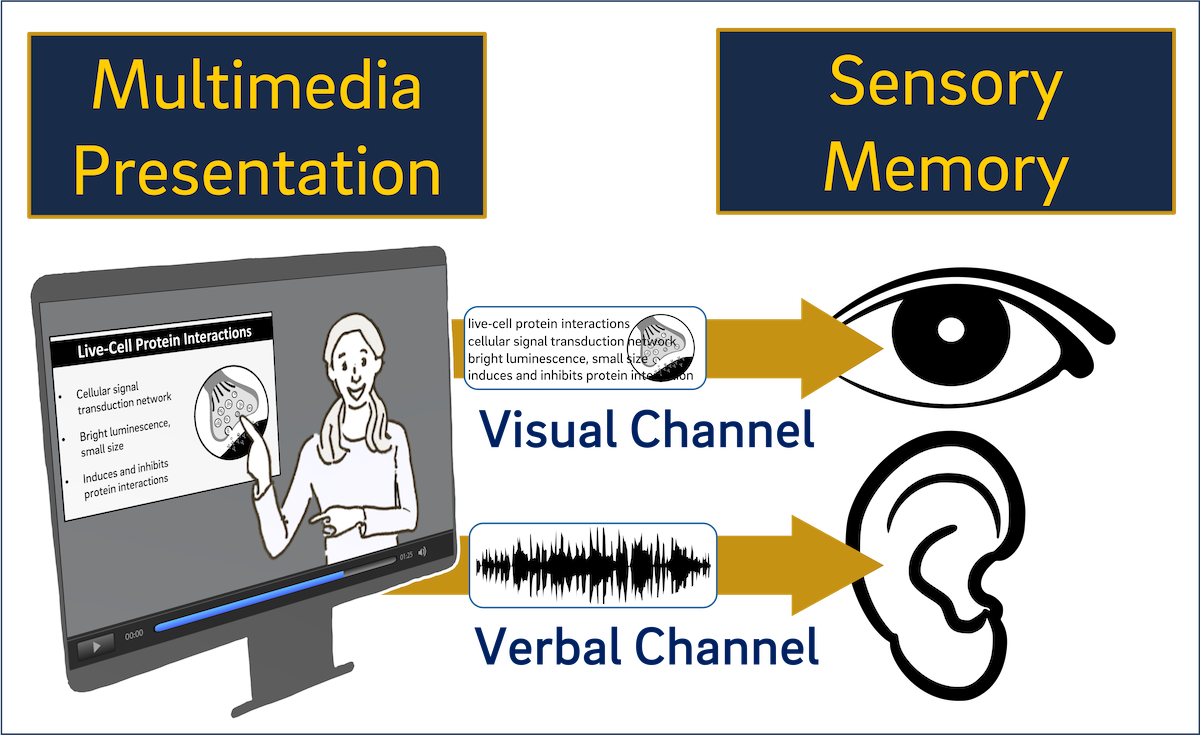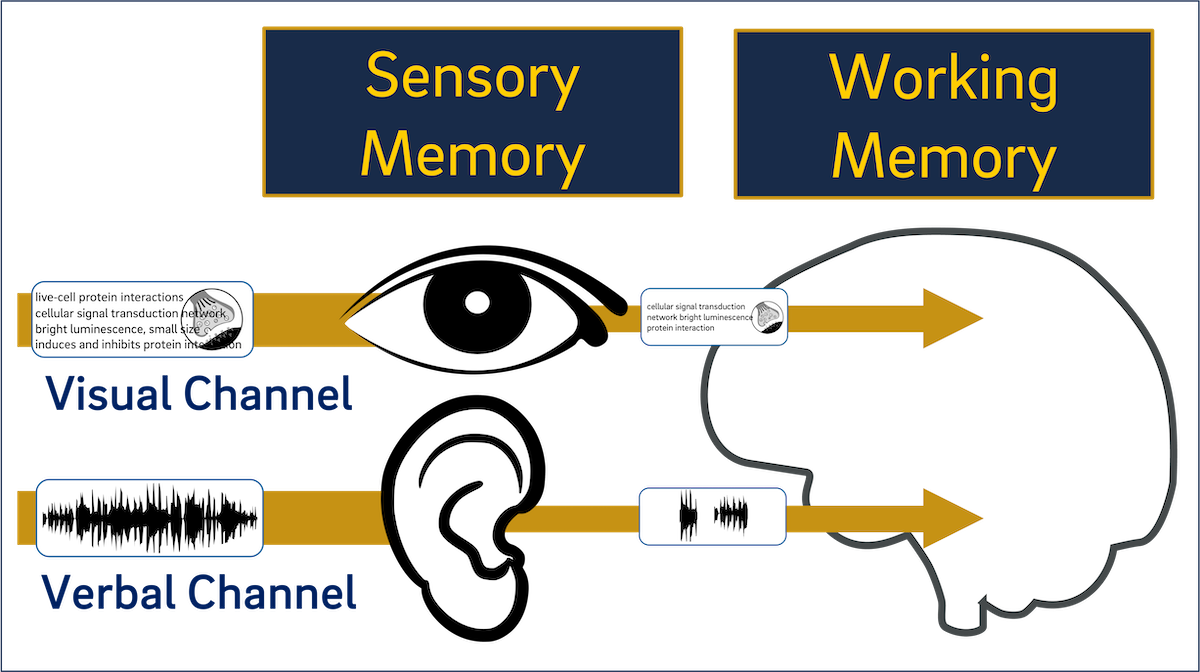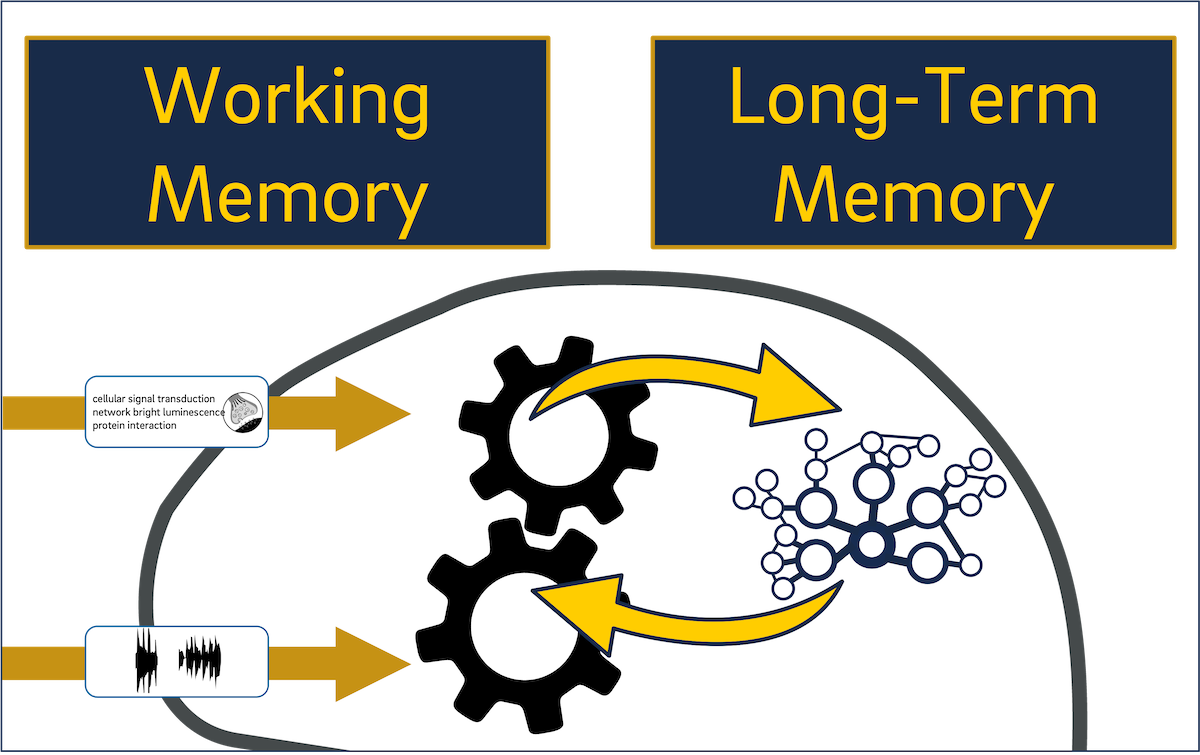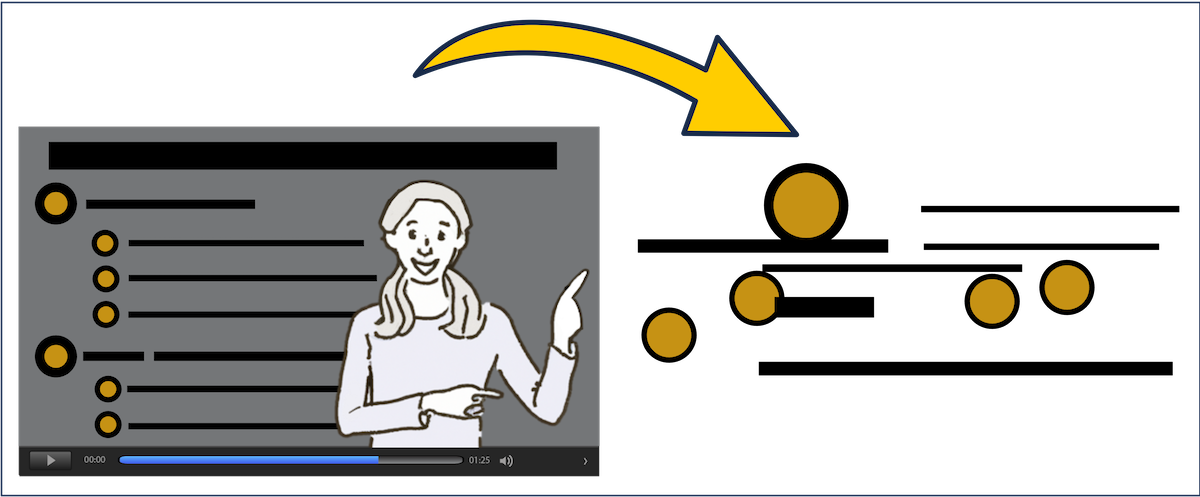Multimedia Learning Principles
The effective design and use of multimedia materials requires an understanding of some basic cognitive psychology principles.
Current best practices for creating effective course videos rely heavily on our understanding of cognitive psychology. It makes sense; the mechanisms by which we process pictures and words and store them in short- and long-term memory provides guidance on how to effectively craft educational "multimedia messages" (pictures and words seen by the eyes and narration heard by the ears).
In this article we’ll discuss the main psychological components of learning through multimedia. Understanding at a core level how the brain processes pictures and words lead to fundamental principles for how to create effective instructional multimedia.
The Short Version
We first start with three assumptions about how we process information, namely:
- The dual channel assumption: We primarily use two channels to learn: a verbal channel for spoken words and a visual channel for images.
- The limited capacity assumption: We have limits on how much we can perceive at any given time.
- The active processing assumption: Actual learning requires effort.
- Selecting: The learner must identify and select the most important pieces of information.
- Organizing: Learners must then organize that selected information into a model that makes sense to them.
- Integrating: Finally, they have to integrate that model with what they already know (their prior knowledge).
Active processing, though, is one of three main kinds of cognitive effort we can expend during learning. Cognitive load theory suggests that there are three:
- Generative load: the effort involved in active processing.
- Intrinsic load: the effort required to represent the material in working memory (based on its complexity).
- Extraneous load: cognitive effort wasted on things that don't support learning goals.
Understanding the details of this cognitive theory of multimedia learning will help to provide a framework for how to leverage what we know about human perception and cognition to design effective multimedia.
The Cognitive Theory of Multimedia Learning
In his book Multimedia Learning, Richard Mayer wishes to develop what he calls a cognitive theory of multimedia learning. In order to do so, he relies on three main assumptions about how we process information when the brain perceives a multimedia message:
- The dual channel assumption
- The limited capacity assumption
- The active processing assumption
The Dual Channel Assumption
We have two separate intakes or "channels" for processing a multimedia message: the visual channel and the auditory channel.
 The visual channel processes images seen through the eyes (both pictures as well as printed words) while the auditory channel processes spoken words. So, if the multimedia message is a narrated PowerPoint presentation, the visual content of the slide is processed by the visual channel and the words spoken by the presenter are processed by the auditory channel. Interestingly, if there are printed words, those are first processed in the visual channel but then move to the auditory channel.
The visual channel processes images seen through the eyes (both pictures as well as printed words) while the auditory channel processes spoken words. So, if the multimedia message is a narrated PowerPoint presentation, the visual content of the slide is processed by the visual channel and the words spoken by the presenter are processed by the auditory channel. Interestingly, if there are printed words, those are first processed in the visual channel but then move to the auditory channel.
The Limited Capacity Assumption
We have a limit on how much information we can process at any given moment.
 Both the visual and auditory channels have their own separate capacities, but either one can be overwhelmed. For example, speaking too quickly might overwhelm the auditory channel; showing an extremely complicated diagram might overwhelm the visual channel. Effective and strategic use of both channels can, however, "split the load," allowing for more energy to be devoted to active learning rather than decoding.
Both the visual and auditory channels have their own separate capacities, but either one can be overwhelmed. For example, speaking too quickly might overwhelm the auditory channel; showing an extremely complicated diagram might overwhelm the visual channel. Effective and strategic use of both channels can, however, "split the load," allowing for more energy to be devoted to active learning rather than decoding.
The Active Processing Assumption
In order for learning to occur, the learner must expend cognitive effort.
 This assumption implicitly affirms a constructivist model of learning. That is, we don't learn by passively absorbing information (the so-called "empty vessel" model), but rather we have to consciously engage in cognitive activities (such as "paying attention, organizing incoming information, and integrating incoming information with other knowledge") (Mayer 2009). Because effort is needed, active processing requires motivation on the part of the learner.
This assumption implicitly affirms a constructivist model of learning. That is, we don't learn by passively absorbing information (the so-called "empty vessel" model), but rather we have to consciously engage in cognitive activities (such as "paying attention, organizing incoming information, and integrating incoming information with other knowledge") (Mayer 2009). Because effort is needed, active processing requires motivation on the part of the learner.
Active Processing
One of the assumptions within the cognitive theory of multimedia learning is that learners must expend effort in order to learn. So let's look closer at what occurs during "active processing." As suggested earlier, learners aren't "empty vessels" waiting to be filled up with information by an expert.
At a high, level, there are three sequential activities that occur during active processing of new information:
- Selecting relevant material
- Organizing the selected material into coherent representations
- Integrating those representations with prior knowledge
Selecting Relevant Material
The learner must first select the most important pieces of information.
 As mentioned above, the brain has a limited capacity to process information at any given moment, so learners have to figure out the most important bits. Effective instructional and multimedia design can aid this process considerably, in particular by drawing attention to salient words and images (through, say, animations or arrows). Once selected, the material moves to the learner's working memory (the cognitive system where information can be manipulated).
As mentioned above, the brain has a limited capacity to process information at any given moment, so learners have to figure out the most important bits. Effective instructional and multimedia design can aid this process considerably, in particular by drawing attention to salient words and images (through, say, animations or arrows). Once selected, the material moves to the learner's working memory (the cognitive system where information can be manipulated).
Organizing Selected Material
Learners must then represent those selected materials in a verbal and/or pictorial model that makes sense to them.
 Once in working memory, the learner must establish structural relationships between the selected materials and build a mental model of some sort. Given that this step takes slightly more conscious effort on the part of the learner, this step is somewhat dependent on the learner's motivation.
Once in working memory, the learner must establish structural relationships between the selected materials and build a mental model of some sort. Given that this step takes slightly more conscious effort on the part of the learner, this step is somewhat dependent on the learner's motivation.
Integrating Representations
Lastly, learners must integrate the representations of selected material with what they already know.
 During the "organizing" phase, learners establish relationships between the new materials in working memory, but during integration, the learner brings prior knowledge out of long-term memory and has to fit in the new material with the old. Given that all knowledge is built on a foundation of prior knowledge, this is a crucial step. (As Mayer says in Multimedia Learning, “Prior knowledge is the single most important individual difference dimension in instructional design" (2009).)
During the "organizing" phase, learners establish relationships between the new materials in working memory, but during integration, the learner brings prior knowledge out of long-term memory and has to fit in the new material with the old. Given that all knowledge is built on a foundation of prior knowledge, this is a crucial step. (As Mayer says in Multimedia Learning, “Prior knowledge is the single most important individual difference dimension in instructional design" (2009).)
Cognitive Load
The limited capacity assumption suggests that both the visual and auditory channels can be oversaturated by excessive cognitive load. As Ambrose et al describe it, cognitive load refers to "the total information-processing demands imposed by a given task or set of tasks," and when there are too many, students don't have enough attention left to attend to the material properly (2010). Partly because of its strong implications for instructional design, cognitive load theory has become foundational in multimedia learning research.
There are three types of cognitive load: intrinsic, generative, and extraneous. All are the result of the arrangement and relationship of the components of the multimedia message (i.e. its words and pictures). Because cognitive load is the product of instructional design, understanding the learning impact of and management strategy for each type of cognitive load is crucial for creating effective course videos.
| Cognitive Load | Description | Instructional Strategies |
|---|---|---|
| Intrinsic | Cognitive effort required to represent the multimedia message in working memory. While this load depends somewhat on the specific learner (particularly whether they're a novice or expert), it's largely dictated by the complexity of the material. |
Segment: break information down into more manageable segments to reduce intrinsic load. (Also referred to as "chunking".) E.g.:
|
| Generative | Cognitive effort required to process and integrate the multimedia message. This is essentially the last two stages of information processing work described above: organizing selected material into coherent models, and integrating those models with prior knowledge. |
Signal: draw attention to the most relevant or salient pieces of information to optimize generative load. This helps students identify what materials to include in their mental models. E.g.
|
| Extraneous | Cognitive effort wasted on material that doesn't support learning outcomes. While this includes distractions, this kind of load can be generated by material that doesn't need to be included in the lesson. |
Weed: remove all material not directly related to learning objectives to minimize extraneous load. E.g.:
|
Although segmenting (or "chunking") is a good instructional design strategy, there's admittedly only so much that instructors can do to reduce the intrinsic load of their material - that is, the inherent complexity of the subject. Signaling and weeding, however, are lower-hanging fruit, so to speak, particularly if you have existing material with which you're working (e.g. a script or a PowerPoint presentation).
Admittedly, however, weeding can sometimes be difficult. For example, perhaps you intend to tell a humorous anecdote during your course video that used to get some good laughs when you performed the lecture in person. The danger is that sometimes extraneous materials like these are better retained than the essential material! Mayer refers to these as seductive details: "interesting but irrelevant material that is added to a passage in order to spice it up" (2009). Common sense might suggest that arousal promotes engagement, which in turn helps students learn, but the research is clear that extraneous materials just compete for our limited cognitive resources and take away from meaningful, active learning.
Understanding how we process information is crucial for developing effective course videos; indeed, for developing effective multimedia presentations of any kind. The assumptions on how we process spoken words and pictures, for example, suggest that we should reduce the amount of information we present at any given time and split (not duplicate) multimedia messages between the visual and auditory channels effectively. The mechanisms of active processing suggest that we need to help learners make sense of the material and create conceptual scaffolds. Lastly, cognitive load theory suggests that we should chunk our materials and draw learners' attention to what's most important and relevant.
Overall, the cognitive psychology underpinning multimedia learning theory strongly - if implicitly - advocates for a constructivist approach to teaching and learning. Instead of dumping knowledge into students, instructors must instead tactically encourage students to engage in active learning through the design of their materials while being mindful of how much information that they, as presumed novices, can process.
Check out our presentation design guide, which leverages these and other psychological principles to offer practical tips on how to design visual aids.
References
Ambrose, Susan A., Bridges, Michael W., DiPietro, Michele, Lovett, Marsha C., & Norman, Marie K. (2010). How learning works: 7 research-based principles for smart teaching. San Francisco, CA: Jossey-Bass.
Brame, C. J. (2016). Effective educational videos: Principles and guidelines for maximizing student learning from video content. CBE—Life Sciences Education, 15(4). https://doi.org/10.1187/cbe.16-03-0125
Mayer, R. E. (2009). Multimedia learning (2nd ed.). Cambridge, England: Cambridge University Press.
Have additional questions about video? Contact Multimedia Services at multimedia@ucsd.edu.